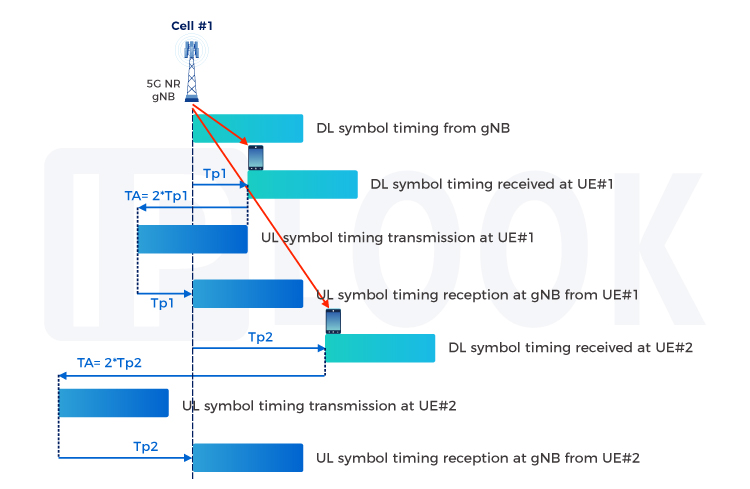Since User Equipment (UE) devices can be at varying distances from the cell site (base station), they experience different signal propagation delays. This can cause uplink transmissions to arrive out of sync, leading to interference and disruptions.
This is where Timing Advance (TA) comes in. It acts like a conductor, orchestrating perfect timing for a smooth flow of data. The cell site transmits TA commands to each UE based on different distances, essentially instructing it to adjust its uplink transmission timing. By factoring in the signal propagation delay, the TA command ensures that UEs farther away transmit slightly earlier than those closer to the cell tower. In this way, uplink transmissions from all UEs arrive at the cell in sync, minimizing interference.
The below figure shows the timing behavior of two UEs at different locations with Timing Advance. The gNB sends TA to ensure the Uplink from both the UEs reach to gNB in 5G NR at the same time. UE#1 has TA= 2*Tp1 and UE#2 has TA=2*Tp2 (Tp is signal propagation delay).

Imagine two employees, Employee A and Employee B, who need to arrive at the office simultaneously. Employee A lives closer to the office, while B lives farther away. To ensure they both reach the office at the same time, their manager (TA) asks B to leave home earlier, considering the extra travel time needed. By doing so, Employee A and Employee B can arrive at the office simultaneously for their meeting. Timing Advance works in the similar way.
Key Points of TA
· Control and Implementation: Managed by the MAC layer (responsible for network access) and implemented by the Physical Layer (responsible for signal transmission).
· Dynamic Adjustment: The TA value depends on the specific signal propagation delay for each UE, resulting in unique TA values for different UEs.
· Synchronization Goal: The objective of TA is to synchronize uplink transmissions from all UEs, ensuring they reach the cell at the same time.
By maintaining precise timing alignment, TA offers significant benefits, including:
· Reduced Errors: Signals from various UEs arrive at the cell site in sync, minimizing data corruption.
· Enhanced Call Quality: Improved clarity for voice calls and video streaming experiences.
· Increased Efficiency: Less time is wasted re-transmitting data packets due to interference, leading to a more efficient network.

